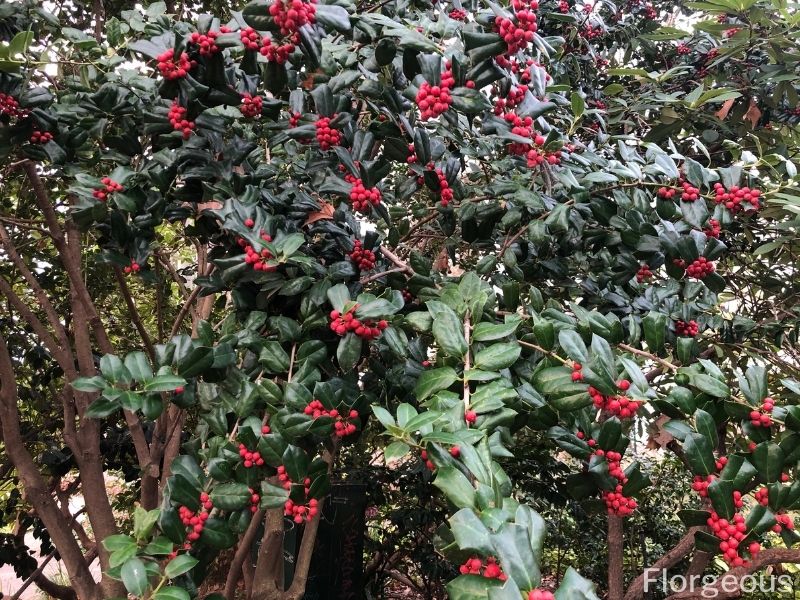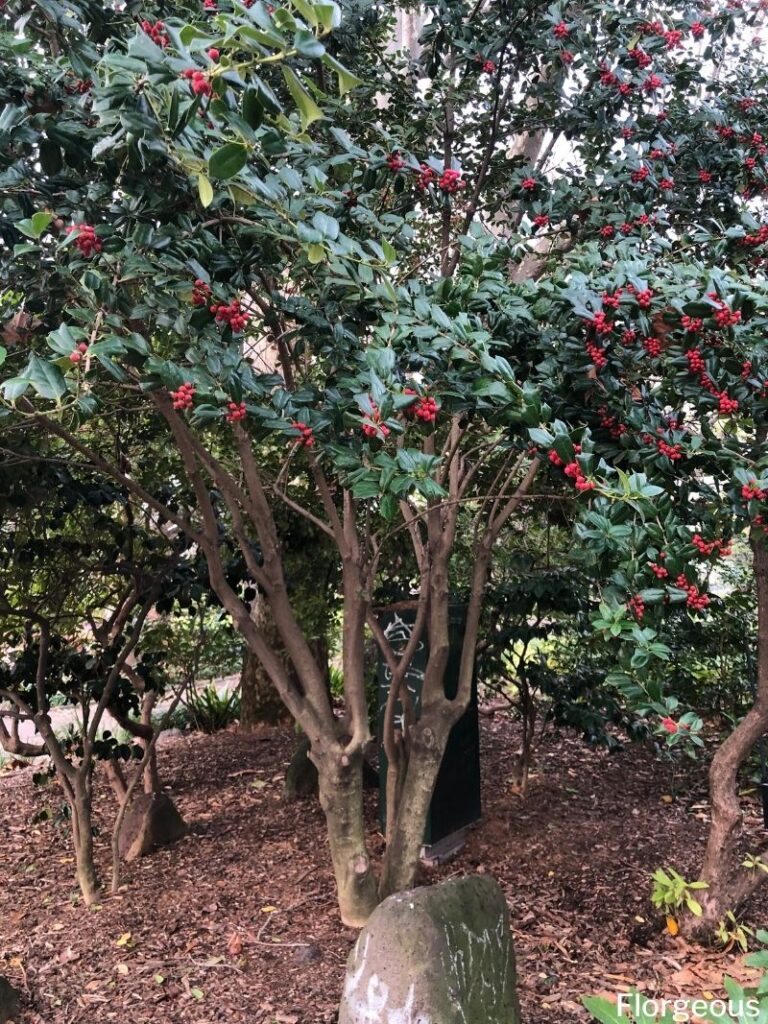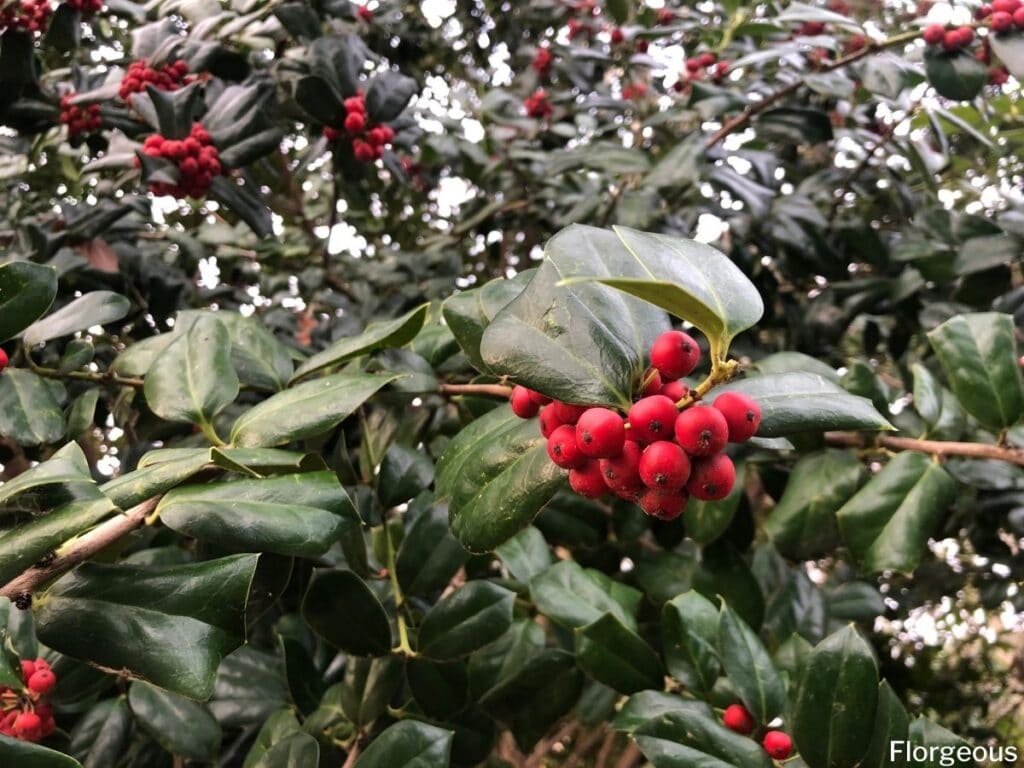Are you wondering how to grow your own holly flowers? If so, this article should help you learn the ropes.
Holly plants are the perfect choice for home decorating, particularly around the holidays.
They can be used as a centerpiece for your dining room table or in an arrangement on your living room wall.
But how can you find enough holly shrub to fill your home – especially during the off-season?
It’s simple – you need to learn how to grow your own holly shrubs to produce your own floral accents, right at home.
Here are some tips on how to grow and care for holly, no matter what your experience level in gardening might be.
What is a Holly Plant?
Holly, or Ilex, is a genus of nearly 500 different flowering plants in the Aquifoliaceae family. These plants with their lush evergreen foliage are typically grown as shrubs or small trees and are widespread throughout the subtropical and temperate regions of the world.
There are several species that are most often used as ornamental plants, including common European holly, box-leaved holly, and winterberry, though there are many cultivars that have been developed for gardening use.
It is the European holly that is most often referenced to at Christmas time. Used as a traditional Christmas decoration, it is often referred to as Christ’s thorn.

Growing Holly Shrub
The ideal environment in which to grow holly bush will be one that has neutral, well-draining soil. It can be slightly acidic but holly plants should be positioned in full sun.
Those are the ideal conditions – but it is important to note that these tough plants thrive in less than ideal spots, too. They can thrive even in very dry or very swampy soil.
Just keep in mind that, if you are growing this plant primarily for the beauty of its bright-colored berries, you’ll need to have both male and female hollies. Not all of these plants produce berries – only the female plant does this.
Because of this, you should plant a female variety with a male variety nearby. There are some cultivars that do not require the presence of a male plant to set fruit so this is another alternative.
Holly doesn’t transplant well so it’s best to consider the full-grown size when choosing your planting spot and to instead buy one that’s been started from cuttings (or start your own cuttings) or plant seeds.

How to Plant Holly Bush
The best way to plant holly bushes is to do so from cuttings. This plant can be propagated from cuttings of year-old growth. Seed propagation is another possibility, though this is significantly more challenging.
It takes some time to get your plants established, so be patient! It might take up to three years for a bloom and even longer than that for holly berries.
Before planting, conduct a soil test. Make sure the pH is around 5.0 to 6.0. Soil that is too alkaline can cause the leaves of this plant to yellow. If you need to increase the acidity of the soil, add some peat moss or pine needle mulch, or a bit of aluminum sulfate.
When selecting your planting spot, remember that holly bush contains saponins that are mildly toxic when ingested. All parts of the plant can be toxic so try not to plant your specimens in a spot where pets and children will have easy access to it.
To plant, dig a hole that is two to three times wider than the roots of the plant and not quite as deep. If growing from a container, remove the plant from the container and tease the roots.
Add some compost to your hole.
Place your plant into the planting area so that the roots are level with the surface of the soil. Backfill with soil and more compost, firm around the plant, then water thoroughly.

Caring for Holly Bushes
Your work doesn’t end once your holy plants are in the ground – follow these tips for caring for holly shrubs.
Watering
Hollies do best with a moderate amount of water. Try to keep the soil evenly moist, watering just once or twice per week during dry or hot spells. When your bushes are first becoming established, you may need to water even more often than that to help them develop healthy root systems.
Weeding
Mulching is one of the most effective ways to prevent weeds from germinating around – and threatening the health of – your holy plants. Add a two- to three-inch-thick layer of organic matter to help suppress weeds.
This should be done at the time of planting and can be repeated as needed later on in your plant’s life. You can use any kind of material you want but organic mulches like grass clippings, compost, and wood chips tend to work best as they’ll conserve moisture and add nutrients back to the soil as they decompose.
Fertilizing
To fertilize your plants, use a slow-release product that is created specifically for evergreen shrubs that love acidic soil. A fertilizer that you use for plants like rhododendrons and camellias should do the trick, but there are some companies that sell holly-specific fertilizers, too.
You should apply fertilizer in the spring, right before the first flush of new growth, and again in the autumn, according to the instructions on your package.
Of course, you can always use a bit of aged compost on your plants instead. This will provide them with all the nutrients they need with no chemicals required!
Pests and Diseases
One of the biggest pests you’ll have to worry about hanging around your shrubs is, surprisingly, birds!
Birds love these bright red berries just like we do (though of course, we don’t tend to eat them!), and they’ll happily snack on your ripened fruits. You can keep them away by installing netting – or leave them be and enjoy their natural beauty in your garden. They won’t be harming your plants by munching on the berries.
Hollies are largely regarded as being resistant to deer and other mammals, but the truth is that some varieties are better at this than others. The varieties with spiny leaves tend to be avoided by most grazers while Japanese and blue holly are often munched on by deer.
When planted in the ideal conditions, there are few other pests and diseases you’ll need to worry about. Most diseases that affect holly plants are fungal in nature, with the most common ones being leaf spot, root rot, canker, and powdery mildew.
These can be prevented by practicing the watering guidelines we mentioned above and by maintaining proper spacing between your plants to allow for air circulation. Consider the mature size of your hollies when you plant. If they end up taking up more space than you anticipated, prune heavily to open up some air space.
Other Tips for Growing Holly Shrub
Holly is a shrub that responds quite well to pruning. You can easily make a hedge or a fun geometric shape by pruning your holly in various ways. If you accidentally overhear your plant, that’s no problem – you can correct your mistake by making deeper cuts to allow light to penetrate through and to rectify any bare spots.
When pruning in the future, only prune back to a growth bud. Completely removing an entire branch or stem can be detrimental as it might not grow back in.
Right before the holidays is a great time to prune your hollies. They’ll respond well to a little “haircut” and you can then use the trimmings to decorate your home for the upcoming holiday season.
Common Types of Holly Bushes
This plant family is large, inclusive of dozens of different shrubs and trees. In this group, you’ll find plants that grow to just a foot and a half tall as well as those that can reach heights of 60 feet or more.
While most varieties are dark green, you’ll also be able to find those with variegated forms or purple tints. You’re sure to find whatever you are looking for!
There are two common types of holly plants – deciduous and evergreen.
Chinese Holly
First on the list is Chinese holly, or Ilex cornuta. It is an evergreen shrub with dark green leaves – these leaves have pronounced spines. The plants tolerate hot temperatures easily but are also able to withstand some winter damage. They are some of the most popular holly cultivars for hedges and other landscaping projects.
American Holly
American holly (I. opaca), despite the name, isn’t as commonly used in landscape settings. That’s because it grows extremely slowly. It can grow up to 60 feet tall and when mature, is absolutely breathtaking to behold. It is an evergreen species.
Japanese Holly
When compared to both American and Chinese holly, Japanese holly, I. crenata, has a softer texture. It can be found in all kinds of shapes and sizes but no matter what you choose, you’ll find that this plant has endless value in the landscape. It doesn’t do as well if you have hot summers but handles cold winter weather with ease.
Yaupon Holly
Yaupon holly, I. vomitoria, is a holly plant with tiny leaves with a purple tint when they are young. Some varieties of yaupon holly have white berries, too, with different cultivars boasting unique characteristics. For example, ‘Bordeaux’ produces leaves that are a deep burgundy color while ‘Pendula’ is a weeping holly plant.
Inkberry Holly
Inkberry holly, I. glabra, is another evergreen species that can be distinguished by its black (ink-like!) berries. This plant usually has bare lower branches since it drops its lower leaves – however some, like ‘Nigra,’ retain their leaves a bit better.
Possumhaw
Possumhaw, I. decidua, is a multi-stemmed shrub that can also be grown as a tree. Despite its odd-sounding name, possumhaw is, in fact, a type of holly. It grows up to 30 feet tall and has dark orange or red berries. These remain on the branches long after the leaves have fallen off.
Winterberry Holly
Winterberry holly, I. verticillata is another deciduous type that grows to just eight feet in height. Within this species, there are many cultivars to choose from, but almost all of these set fruit earlier than any other species.
Holly shrubs are easy to grow and provide an excellent winter backdrop for your garden. If you’re looking for a low maintenance, hardy evergreen shrub that will also help control erosion on hillsides or sloping areas in your yard – while of course adding ornamental value to all of your holiday decorations! – then holly is the perfect plant for you!
FAQs
Is holly OK in full sun?
Yes, Holly (Ilex) can tolerate full sun but also grows well in partial shade. Providing some afternoon shade in hotter climates can help prevent stress and maintain healthy growth. Ensure the holly receives adequate water when grown in full sun to avoid drought stress.
Why are my holly bushes dying?
Holly bushes may die due to various factors, including improper watering, soil issues, pests, diseases, or environmental stressors. Overwatering or underwatering, poor soil drainage, and root rot are common culprits. Pests like spider mites or diseases like root rot can also cause decline.
How do you make holly grow faster?
To encourage faster growth in holly bushes, ensure they are planted in well drained soil with adequate organic matter. Provide regular watering, especially during dry periods, and consider applying a balanced fertilizer in spring to support growth. Prune holly bushes selectively to shape and promote new growth.
Final thoughts
If you’re looking to add a holly bush to your garden, you’ll be pleased to know that they are easy to grow and generally require little pruning. They are also low maintenance and look great planted in a patio planter.
To keep your holly bush healthy, it’s important to fertilize it once a year with a balanced fertilizer and apply mulch annually to keep the roots moist and cool during hot summers. These holly bush care tips will help you grow and prune holly to your advantage and ensure that your holly bush thrives for years to come.
References
Reference list:
Clemson University Cooperative Extension: Holly
University of Illinois Extension: Growing holly
University of Florida: Holly
Close






